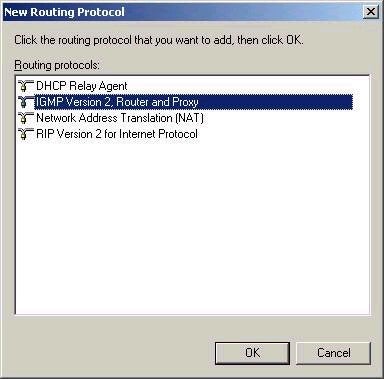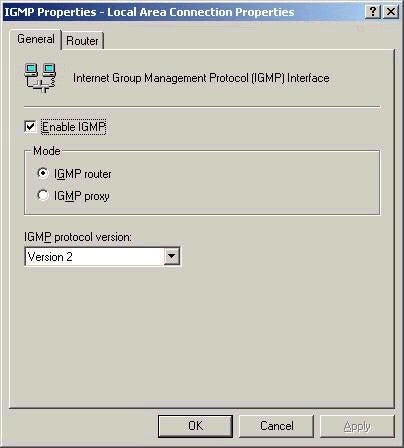Multicast Routing
Windows 2000 Routing and Remote Access also has the ability to act as a multicast router, using the IGMP router and proxy protocol (it supports IGMP version 2, which is backwards compatible with version 1). For those not familiar with multicasts, this is a type of transmission that is sent to a class D address. Multiple hosts listen in on a given class D address, and all hosts that are part of this group receive the transmission. Note that IGMP is not actually a data transmission protocol, but rather the protocol that keeps track of multicast group membership. The beauty of multicasting is that the transmission is sent only once by the sender, and can be received by many many hosts. The key in any multicast implementation is that the routers used should support the ability for hosts to register and unregister as part of the multicast group – this controls where multicasts go, which also ensures that the multicast only goes to network where it is required. Note that in cases where routers do not support multicasts, it is possible to set up IP-to-IP tunnels, while allow multicast traffic to be forwarded between two multicast-enabled routers, even if intermediary routers do not support this type of routing functionality.
Multicast registration is actually a simple idea. When a host on a given subnet wants to receive a multicast, it contacts its local router and asks it to forward traffic for the particular class D address onto this subnet. The router then contacts its upstream router, asking it to send the multicast, and so on and so forth. As other hosts on the original subnet ask to receive the multicast the router simply adds them to the multicast group, a list of who needs the multicast. Understand that this does not mean that the multicast will be sent onto the subnet multiple times. Instead, it will be forwarded once, and all hosts who are participating will grab the transmission. The router keeps track of who wants the multicast with periodic polling, and will cease forwarding it once nobody wants it. The portion of the Internet that supports multicasting is referred to as the MBONE.
While Windows 2000 can act as a simple multicast router as mentioned earlier, it is actually not full-featured because it doesn’t actually use a proper multicast routing protocol (such as DVMRP). Instead, it does something interesting. On the client side of the router, it acts as a multicast router, handling registration requests. However, on the Internet side of the connection is acts as just another multicast client, registering with its upstream router. The leads to the two ‘modes’ in which the interfaces on the system must be configured – Router mode and Proxy mode. For the sake of clarity, just remember that the Internet interface (or side) should always be configured in Proxy mode, while the private network interface should always be configured in Router mode.
In order to configure Windows 2000 as a multicast router, first add IGMP under routing protocols in Routing and Remote Access, as shown below:

Once added, you next need to add interfaces,
which is done by right clicking on IGMP and choosing New Interface. In
adding the new interfaces, you must choose whether they will be configured
in either Router mode or Proxy mode, as shown below.

Be sure that the interfaces have been configured in the correct manner, or the multicast routing will not function correctly. After both (or more) interfaces have been configured, Windows 2000 will function as a multicast router. Remember from previous articles that Windows 2000 can also be configured with Multicast scopes for automatic multicast address allocation (via MADCAP in DHCP).
Based on the length of this article, we’ll have to pick it up from here next week. Thanks so much to all those who have contacted me recently with words of support, I appreciate your comments. Next week’s article will most likely cover an assortment of topics including NAT, ICS, IAS and whatever else fits. Beyond that, you can expect articles covering certificate services and IPSec following shortly. Please remember that all technical questions should be posted to my message board. Until next week, best of luck with your studies.
Dan

